
Компания Chengdu Ebyte Electronic Technology Co.,Ltd.
The application of LoRa in smart home

In 2020, China's smart home has entered the AIoT empowerment period, which will comprehensively innovate the form of smart home products. From the perspective of market size, the smart home market will reach about 153 billion yuan in 2019, and will reach 182 billion yuan in 2020. From the perspective of device shipments, China's smart home market shipments reached 208 million units in 2019 and are expected to reach 215 million units in 2020. From the perspective of user geographical distribution, the distribution ratio of smart home users in first-tier cities is 29.3%, and the second-tier cities and new first-tier cities are 23.4% and 19.8% respectively. 48% of end users tend to use smart panels, and 25% and 23% tend to use language control and mobile APP control, respectively.
In the future, with the continuous development of Internet of Things technology and the accelerated commercialization of 5G technology, smart homes will continue to enter thousands of households and become the trend of future smart home development.
In a sense, LoRa has realized people's desire for horses to run but not to eat grass. LoRa has the characteristics of low power consumption and long distance, and realizes the unity of the two contradictions of low power consumption and long distance. very powerful. LoRa's market applications have also expanded from industry-class low-power wide-area networks (LPWANs) to smart home, community, and consumer applications, providing low power consumption and broad coverage for Internet of Things (IoT) devices in indoor and adjacent areas to connect Sensors and actuators for security, environmental monitoring, and convenience applications.
Assuming the usage scenario is a smart home, home appliances such as living room lights, kitchen lights, bedroom A lights, bedroom B lights, water heaters, bedroom A air conditioners, bedroom B air conditioners, and balcony curtains are connected to the E220 series modules. And the data is sent to the lora gateway, the LORA gateway uploads the data to the server through protocol conversion, and the server displays the status on the mobile APP after processing; the APP can view and control all home appliances, and can also set flexible automation, such as setting the curtain switch time, or through the value of the light sensor for linkage, etc.; after the APP is set, the server sends the command to the LORA gateway, and then sends it to the corresponding E220 module after protocol conversion. Appliances work as instructed and give feedback.
Of course, here is just an example. The low power consumption performance of lora itself can be well applied to the environment of smart home, and it can also be applied to many industries such as smart agriculture, smart community, and smart security at a long distance.
LoRa smart home adopts a point-to-point star communication method, which is a communication technology used to connect smart home devices and collect, organize and feedback data. It can be found in smart switches, infrared, temperature and humidity sensors and other devices.
Compared with wifi and bluetooth, its power consumption is much less
Communication distance is longer
No need for network repeater transmission distance
Smart accessories can directly interconnect with the smart central control host, and do not need a large number of nodes in the middle to convey
RS485/RS232 IO
CAN
CAN2.0 Communication Module
Antenna&Power
Compared with other communication technologies, LoRa technology is more suitable for low-cost large-scale IoT deployment